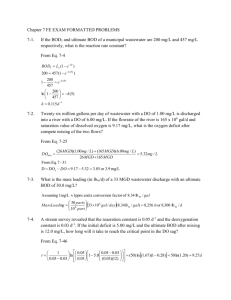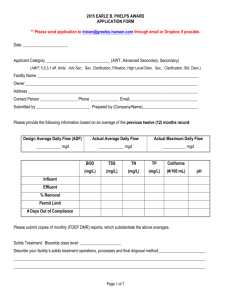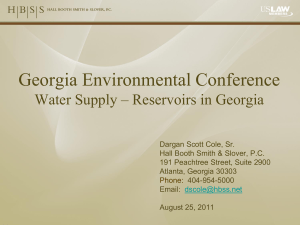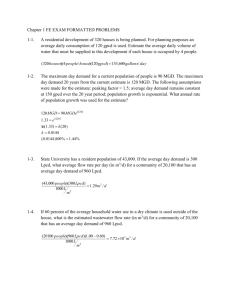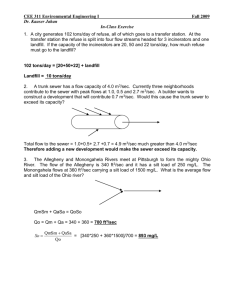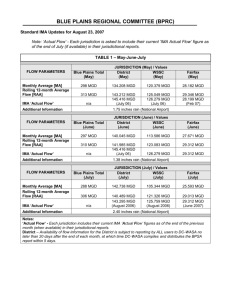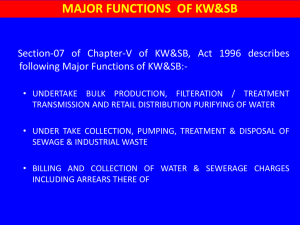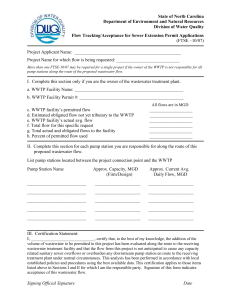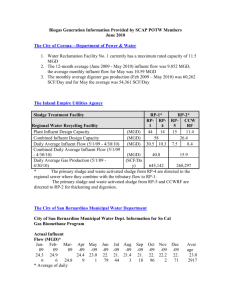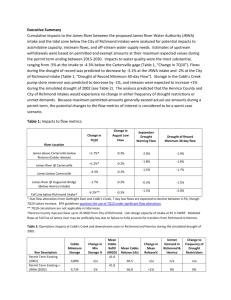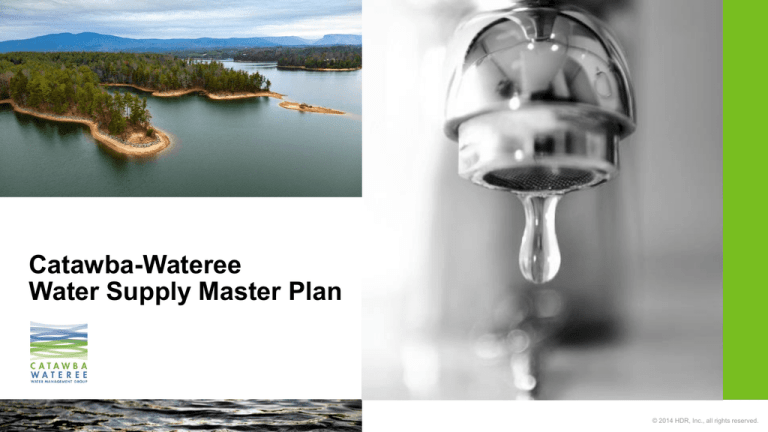
Catawba-Wateree
Water Supply Master Plan
© 2014 HDR, Inc., all rights reserved.
Background
2006 Water Supply Study found maximum
capacity of Catawba River Basin for water
supply could be reached mid-century
Catawba-Wateree Water Management
Group incorporated - December 2007
Water Supply Master Plan commissioned in
2010
Purpose of Master Plan is to find ways to
extend the time before the capacity of the
Basin is reached
The Catawba-Wateree
River Basin
4,750 square miles
Supports nearly two million people with
water for drinking, power generation,
industrial processes, crop and livestock
production, recreation, irrigation, and more
Acknowledgements/Thanks
Project was funded by:
Duke Energy Foundation
North Carolina Department of Environment and
Natural Resources
South Carolina Department of Natural Resources
Catawba-Wateree Water Management Group
Elements of the
Master Plan
Supplemental funding
Stakeholder input
Water use projections
Refinement of hydrologic model
Climate change impacts
Develop & evaluate options
Action plan and schedule
Publish report
Implementation, on-going public input
Periodic future updates
Stakeholder Advisory Team (SAT)
Advisory level input by key organizations with an interest in future planning efforts for the Basin
Intended to ensure a broad level of input from a diverse group of interested stakeholders
Industrial
7.7, 2%
How Water will be
Used (2065)
Million gallons per day
(mgd) consumed and
percent of total 419.4 mgd
Steam/Electric Power
178.3, 43%
Public Water Supply
198.5, 47%
Agriculture/Irrigation
34.9, 8%
Water Use Projections
Pre-Master Plan Project
Research
Safe Yield Study
o
o
How to define and determine safe yield
Can safe yield be increased?
Sedimentation Monitoring Study
Water Use Efficiency Study
Low Inflow Protocol Response Evaluation
Study
Full reports can be found at
www.catawbawatereewmg.org
Population and Climate Change
Sensitivity Analysis
Evaluated variation in population growth
Evaluated climate change impacts
o
o
o
No impacts
Baseline (moderate) impacts – focused on temperature rise
High impact – temperature rise and reduced precipitation/inflow
CWWMG – First in the region to incorporate climate change into water use planning
Individual and Integrated Future Planning Scenarios
Playing the “What If?” Game with a Robust Water Model
Baseline
Population growth
Climate change
Public water supplier water use changes (water use efficiency, reroute wastewater)
Power consumptive water use changes (e.g. relocation of demand)
New off-stream storage reservoirs
Critical intake modifications
Effluent flow recycling
Modified reservoir operations
Low Inflow Protocol (drought management plan) modifications
Results and
Recommendations
Improve safe yield of the
Basin by over 200 mgd
Extend water yield by 40
years
Key Recommendations
Increase water use efficiency
Lower critical water intakes/elevations
o
o
Power plant
Public water supply
Raise target lake levels during summer months
Enhance drought responsiveness through Low
Inflow Protocol
Water Use Efficiency Recommendations
Example: average per capita use in the Charlotte-Mecklenburg system
o
o
Current
Recommended 2065
~100 gallons/day/person (residential)
~80 gallons/day/person (residential)
CW Reservoir System Water Balance
Where’s the Water Going?
Natural surface
evaporation
204 mgd (all eleven
lakes combined)
(204 mgd)
Surface and
groundwater
inflow
3,752 mgd
(1,491 mgd)
Water withdrawals are average
net amounts for 2006–2013 and
total 189 mgd
(202 mgd)
Public Water
Supply
92 mgd
(98 mgd)
Industrial
3 mgd
(6 mgd)
Values in italics represent corresponding
inflow, withdrawals, and outflow for the
worst 12 months during the 2007-2009
drought (7/01/2007 to 6/30/2008)
Natural inflow, natural
evaporation, and hydro
outflow are annual average
amounts from hydrology
data set used in
CHEOPS™ model
Thermal
Power
74 mgd Irrigation
(78 mgd)
20 mgd
(20 mgd)
Wateree Hydro Station
outflows 3,359 mgd
(1,085 mgd)
* mgd = million gallons per day. To convert to cubic feet per second (cfs), multiply all numbers by 1.5475
So What is Duke Energy’s Role?
Manage the Water Resource
Manage the region’s raw water supply (big, ongoing investment)
Implement Comprehensive Relicensing Agreement (CRA) and new license
Continue making electric customers more energy-efficient. In 2009-2014, Duke Energy’s energy
conservation programs across the Carolinas
o
o
Reduced capacity needs by total of ≈ 1,200 MW (about a nuclear unit)
Reduced energy needs by total of ≈ 2,442,000 MWh (about a billion gallons of water equivalent)
So What is Duke Energy’s Role?
Be a Good Partner
Remain a dues-paying, active member of the
Catawba-Wateree Water Management Group
Help provide leadership and coordination
Implement the Water Supply Master Plan
Pursue the identified initiatives
o
o
o
Water use for thermal plant replacements/additions
Quicker response in Low Inflow Protocol
Increase summer target elevations for selected
reservoirs
Projected Results
Implementation of the Catawba-Wateree
Water Supply Master Plan extends the
River’s capacity to sustain growth
through 2100
Questions?
Complete Water Supply Master Plan Report is available at www.catawbawatereewmg.org
Reference
Additional slides for further discussion
Thermal Power Cooling Technologies Used on the CW
Once-Through Cooling
Used at Marshall, McGuire and Allen
Steam Stations
Pros (compared to cooling towers)
o
o
o
Much more water use efficient
Higher plant efficiency
Thermal refuge for fish in cold months
Cons (compared to cooling towers)
o
o
Heats up the lake (regulated by permit)
Higher risk to fish (impingement and
entrainment)
Thermal Power Cooling Technologies Used on the CW
Cooling Towers (aka Closed Loop Cooling)
Used at Catawba Nuclear Station
Pros (compared to once-through cooling)
o
o
o
Much lower gross water withdrawal rate
Negligible thermal impact to the lake
Reduced risk of impacting fish
Cons (compared to once-through cooling)
o
o
Consumes 30-40% more water per unit of
electricity produced
Lower plant efficiency
Factors Driving Future Thermal Power Cooling
Water Use
Growth
Moving downriver - located water withdrawals
for some new plants further down the river
Future electrical demand projected to double
system
in next 50 years
Energy efficiency success
Research and Development
Thermal power will be a key source
CW lakes will support some portion of growth Water Research Center, Cartersville, GA
Technologies must be proven regionally viable,
Power Plant Retirements, Replacements and reliable and cost-effective at plant scale
Cooling system modification at SCE&G’s
Additions
Wateree Steam Station does not reduce water
Natural gas - most replacement and new
consumption
plants in WSMP are more water use efficient
(gas-fired combined cycle) than existing plants

